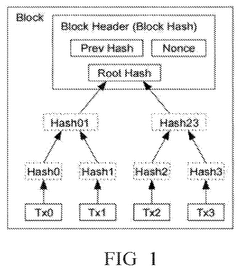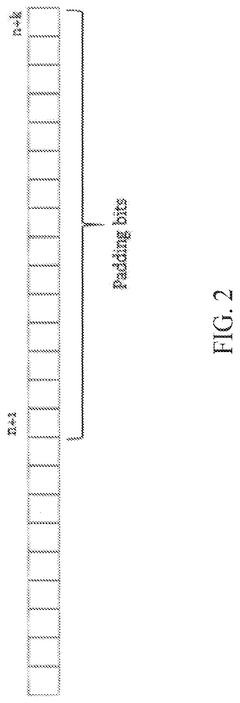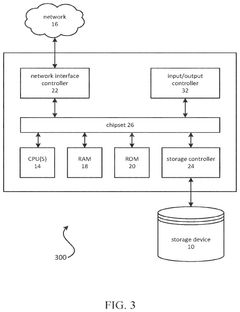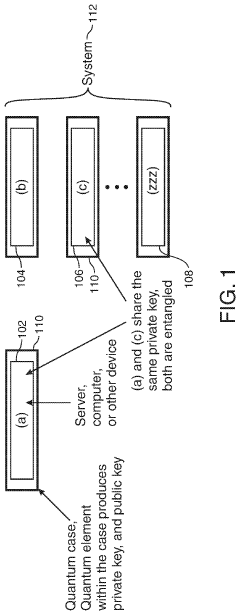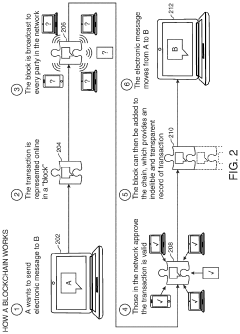Quantum Computing and its Impact on Blockchain Technology
JUL 17, 202510 MIN READ
Generate Your Research Report Instantly with AI Agent
Patsnap Eureka helps you evaluate technical feasibility & market potential.
Quantum Computing Evolution and Blockchain Implications
Quantum computing has undergone a remarkable evolution since its theoretical inception in the 1980s. The field has progressed from abstract concepts to practical implementations, with significant milestones achieved in recent years. Early quantum computers were limited to a handful of qubits, but today's systems boast hundreds of qubits, marking a substantial leap in computational power.
The development of quantum computing has been characterized by breakthroughs in qubit technology, error correction methods, and quantum algorithms. Superconducting circuits, trapped ions, and topological qubits have emerged as leading architectures, each offering unique advantages in stability and scalability. Quantum error correction techniques have advanced, allowing for longer coherence times and more reliable computations.
As quantum computing capabilities have grown, so too has interest in its potential impact on blockchain technology. The relationship between these two fields is complex and multifaceted. On one hand, quantum computers pose a significant threat to the cryptographic foundations of many blockchain systems. Specifically, Shor's algorithm, when implemented on a sufficiently powerful quantum computer, could potentially break the public-key cryptography that secures most blockchain transactions.
This vulnerability has spurred research into quantum-resistant cryptographic algorithms, also known as post-quantum cryptography. These new algorithms aim to secure blockchain networks against potential quantum attacks, ensuring the long-term viability of blockchain technology in a post-quantum world.
Conversely, quantum computing also offers potential benefits to blockchain technology. Quantum-enhanced mining algorithms could dramatically increase the efficiency of proof-of-work systems, while quantum-secure communication protocols could enhance the privacy and security of blockchain networks. Quantum random number generators could provide truly random seeds for blockchain operations, improving overall system security.
The interplay between quantum computing and blockchain is driving innovation in both fields. Blockchain developers are exploring ways to make their systems quantum-resistant, while quantum researchers are investigating applications of their technology to enhance blockchain functionality. This symbiotic relationship is likely to shape the future of both technologies, leading to more secure, efficient, and powerful distributed systems.
As quantum computing continues to advance, its implications for blockchain technology will become increasingly significant. The coming years will likely see a race between quantum computing capabilities and quantum-resistant blockchain solutions, with far-reaching consequences for the future of secure, decentralized systems.
The development of quantum computing has been characterized by breakthroughs in qubit technology, error correction methods, and quantum algorithms. Superconducting circuits, trapped ions, and topological qubits have emerged as leading architectures, each offering unique advantages in stability and scalability. Quantum error correction techniques have advanced, allowing for longer coherence times and more reliable computations.
As quantum computing capabilities have grown, so too has interest in its potential impact on blockchain technology. The relationship between these two fields is complex and multifaceted. On one hand, quantum computers pose a significant threat to the cryptographic foundations of many blockchain systems. Specifically, Shor's algorithm, when implemented on a sufficiently powerful quantum computer, could potentially break the public-key cryptography that secures most blockchain transactions.
This vulnerability has spurred research into quantum-resistant cryptographic algorithms, also known as post-quantum cryptography. These new algorithms aim to secure blockchain networks against potential quantum attacks, ensuring the long-term viability of blockchain technology in a post-quantum world.
Conversely, quantum computing also offers potential benefits to blockchain technology. Quantum-enhanced mining algorithms could dramatically increase the efficiency of proof-of-work systems, while quantum-secure communication protocols could enhance the privacy and security of blockchain networks. Quantum random number generators could provide truly random seeds for blockchain operations, improving overall system security.
The interplay between quantum computing and blockchain is driving innovation in both fields. Blockchain developers are exploring ways to make their systems quantum-resistant, while quantum researchers are investigating applications of their technology to enhance blockchain functionality. This symbiotic relationship is likely to shape the future of both technologies, leading to more secure, efficient, and powerful distributed systems.
As quantum computing continues to advance, its implications for blockchain technology will become increasingly significant. The coming years will likely see a race between quantum computing capabilities and quantum-resistant blockchain solutions, with far-reaching consequences for the future of secure, decentralized systems.
Market Demand for Quantum-Resistant Blockchain Solutions
The market demand for quantum-resistant blockchain solutions has been steadily growing as the potential threat of quantum computing to current cryptographic systems becomes more apparent. As quantum computers advance, they pose a significant risk to the security of existing blockchain technologies, particularly those relying on public-key cryptography. This has created a pressing need for blockchain solutions that can withstand potential attacks from quantum computers.
Financial institutions and governments are among the primary drivers of this demand. Banks, investment firms, and other financial entities are increasingly concerned about the long-term security of their digital assets and transactions. They recognize that quantum computers could potentially break the cryptographic algorithms currently used in blockchain systems, compromising the integrity and confidentiality of financial data. As a result, these institutions are actively seeking quantum-resistant solutions to protect their assets and maintain trust in their systems.
Governments and defense organizations are also key players in driving the demand for quantum-resistant blockchain solutions. They are particularly interested in securing sensitive information and communications that may be vulnerable to quantum attacks. The potential for quantum computers to decrypt classified data has led to increased investment in quantum-resistant cryptography and blockchain technologies.
The cryptocurrency market, which heavily relies on blockchain technology, is another significant contributor to the demand for quantum-resistant solutions. As the value of cryptocurrencies continues to grow, so does the need to protect these digital assets from potential quantum threats. Cryptocurrency exchanges, wallet providers, and blockchain developers are all exploring ways to implement quantum-resistant algorithms to safeguard their platforms and users' investments.
In the enterprise sector, companies dealing with sensitive data and intellectual property are increasingly looking towards quantum-resistant blockchain solutions. Industries such as healthcare, pharmaceuticals, and aerospace are particularly concerned about the long-term security of their data and are exploring blockchain technologies that can withstand quantum attacks.
The demand for quantum-resistant blockchain solutions has also spurred innovation in the field of post-quantum cryptography. Research institutions and technology companies are investing heavily in developing new cryptographic algorithms that can resist quantum attacks. This has led to the emergence of several promising approaches, such as lattice-based cryptography, hash-based signatures, and multivariate polynomial cryptography.
As awareness of the quantum threat grows, regulatory bodies are also beginning to address the need for quantum-resistant solutions. This is creating additional market demand as organizations seek to comply with emerging standards and regulations related to post-quantum cryptography. The National Institute of Standards and Technology (NIST) in the United States, for example, is in the process of standardizing post-quantum cryptographic algorithms, which is expected to further drive adoption of quantum-resistant blockchain solutions across various industries.
Financial institutions and governments are among the primary drivers of this demand. Banks, investment firms, and other financial entities are increasingly concerned about the long-term security of their digital assets and transactions. They recognize that quantum computers could potentially break the cryptographic algorithms currently used in blockchain systems, compromising the integrity and confidentiality of financial data. As a result, these institutions are actively seeking quantum-resistant solutions to protect their assets and maintain trust in their systems.
Governments and defense organizations are also key players in driving the demand for quantum-resistant blockchain solutions. They are particularly interested in securing sensitive information and communications that may be vulnerable to quantum attacks. The potential for quantum computers to decrypt classified data has led to increased investment in quantum-resistant cryptography and blockchain technologies.
The cryptocurrency market, which heavily relies on blockchain technology, is another significant contributor to the demand for quantum-resistant solutions. As the value of cryptocurrencies continues to grow, so does the need to protect these digital assets from potential quantum threats. Cryptocurrency exchanges, wallet providers, and blockchain developers are all exploring ways to implement quantum-resistant algorithms to safeguard their platforms and users' investments.
In the enterprise sector, companies dealing with sensitive data and intellectual property are increasingly looking towards quantum-resistant blockchain solutions. Industries such as healthcare, pharmaceuticals, and aerospace are particularly concerned about the long-term security of their data and are exploring blockchain technologies that can withstand quantum attacks.
The demand for quantum-resistant blockchain solutions has also spurred innovation in the field of post-quantum cryptography. Research institutions and technology companies are investing heavily in developing new cryptographic algorithms that can resist quantum attacks. This has led to the emergence of several promising approaches, such as lattice-based cryptography, hash-based signatures, and multivariate polynomial cryptography.
As awareness of the quantum threat grows, regulatory bodies are also beginning to address the need for quantum-resistant solutions. This is creating additional market demand as organizations seek to comply with emerging standards and regulations related to post-quantum cryptography. The National Institute of Standards and Technology (NIST) in the United States, for example, is in the process of standardizing post-quantum cryptographic algorithms, which is expected to further drive adoption of quantum-resistant blockchain solutions across various industries.
Current State of Quantum Computing and Blockchain Challenges
Quantum computing and blockchain technology are two rapidly evolving fields that have garnered significant attention in recent years. The current state of quantum computing is characterized by substantial progress in hardware development and algorithm design, yet it still faces considerable challenges in achieving practical, large-scale implementations.
Leading tech giants and research institutions have made remarkable strides in quantum computing, with companies like IBM, Google, and Intel unveiling quantum processors with increasing qubit counts. IBM's 127-qubit Eagle processor and Google's 53-qubit Sycamore chip represent significant milestones in quantum hardware development. However, these systems still struggle with qubit coherence times, error rates, and scalability issues, limiting their practical applications.
Quantum algorithms have shown promising theoretical advantages over classical counterparts in certain domains, such as optimization, cryptography, and simulation of quantum systems. Shor's algorithm, for instance, poses a potential threat to widely used public-key cryptography systems. However, the implementation of these algorithms on current quantum hardware remains challenging due to the limitations of Noisy Intermediate-Scale Quantum (NISQ) devices.
Blockchain technology, on the other hand, has seen widespread adoption across various industries, with cryptocurrencies being the most prominent application. The core principles of blockchain – decentralization, immutability, and transparency – have revolutionized data management and trust systems. However, the technology faces its own set of challenges, including scalability, energy consumption, and potential vulnerabilities to quantum attacks.
The intersection of quantum computing and blockchain presents both opportunities and threats. Quantum computing's potential to break current cryptographic systems poses a significant risk to blockchain security. Most blockchain networks rely on Elliptic Curve Digital Signature Algorithm (ECDSA) for transaction authentication, which could be compromised by sufficiently powerful quantum computers running Shor's algorithm.
To address this quantum threat, researchers are exploring post-quantum cryptography (PQC) solutions that could withstand attacks from quantum computers. The National Institute of Standards and Technology (NIST) is leading efforts to standardize quantum-resistant cryptographic algorithms, with several promising candidates under consideration.
Despite these challenges, quantum computing also offers potential benefits to blockchain technology. Quantum-inspired algorithms could enhance the efficiency of mining processes, improve consensus mechanisms, and optimize smart contract execution. Furthermore, quantum key distribution (QKD) could provide unhackable communication channels for blockchain networks, enhancing overall security.
As both quantum computing and blockchain continue to evolve, their interplay will likely shape the future of secure, decentralized systems. The race between quantum computing advancements and the development of quantum-resistant blockchain solutions will be crucial in determining the long-term viability and security of blockchain technology in a post-quantum world.
Leading tech giants and research institutions have made remarkable strides in quantum computing, with companies like IBM, Google, and Intel unveiling quantum processors with increasing qubit counts. IBM's 127-qubit Eagle processor and Google's 53-qubit Sycamore chip represent significant milestones in quantum hardware development. However, these systems still struggle with qubit coherence times, error rates, and scalability issues, limiting their practical applications.
Quantum algorithms have shown promising theoretical advantages over classical counterparts in certain domains, such as optimization, cryptography, and simulation of quantum systems. Shor's algorithm, for instance, poses a potential threat to widely used public-key cryptography systems. However, the implementation of these algorithms on current quantum hardware remains challenging due to the limitations of Noisy Intermediate-Scale Quantum (NISQ) devices.
Blockchain technology, on the other hand, has seen widespread adoption across various industries, with cryptocurrencies being the most prominent application. The core principles of blockchain – decentralization, immutability, and transparency – have revolutionized data management and trust systems. However, the technology faces its own set of challenges, including scalability, energy consumption, and potential vulnerabilities to quantum attacks.
The intersection of quantum computing and blockchain presents both opportunities and threats. Quantum computing's potential to break current cryptographic systems poses a significant risk to blockchain security. Most blockchain networks rely on Elliptic Curve Digital Signature Algorithm (ECDSA) for transaction authentication, which could be compromised by sufficiently powerful quantum computers running Shor's algorithm.
To address this quantum threat, researchers are exploring post-quantum cryptography (PQC) solutions that could withstand attacks from quantum computers. The National Institute of Standards and Technology (NIST) is leading efforts to standardize quantum-resistant cryptographic algorithms, with several promising candidates under consideration.
Despite these challenges, quantum computing also offers potential benefits to blockchain technology. Quantum-inspired algorithms could enhance the efficiency of mining processes, improve consensus mechanisms, and optimize smart contract execution. Furthermore, quantum key distribution (QKD) could provide unhackable communication channels for blockchain networks, enhancing overall security.
As both quantum computing and blockchain continue to evolve, their interplay will likely shape the future of secure, decentralized systems. The race between quantum computing advancements and the development of quantum-resistant blockchain solutions will be crucial in determining the long-term viability and security of blockchain technology in a post-quantum world.
Existing Quantum-Resistant Blockchain Implementations
01 Quantum Circuit Design and Optimization
This area focuses on developing and optimizing quantum circuits for various applications. It involves creating efficient quantum gate sequences, reducing circuit depth, and improving overall performance of quantum algorithms. Techniques may include circuit compression, gate decomposition, and noise-aware circuit design to enhance the capabilities of quantum computers.- Quantum Computing Architectures: Various architectures for quantum computing systems are being developed, including superconducting circuits, trapped ions, and topological qubits. These architectures aim to improve qubit coherence, scalability, and error correction capabilities, enabling more powerful and reliable quantum computations.
- Quantum Error Correction and Fault Tolerance: Techniques for quantum error correction and fault-tolerant quantum computing are crucial for mitigating the effects of decoherence and errors in quantum systems. These methods involve encoding quantum information across multiple physical qubits and implementing error detection and correction protocols.
- Quantum Algorithms and Applications: Development of quantum algorithms for various applications, including optimization, cryptography, and simulation of quantum systems. These algorithms leverage the unique properties of quantum systems to potentially outperform classical algorithms for specific problems.
- Quantum-Classical Hybrid Systems: Integration of quantum and classical computing systems to create hybrid architectures that leverage the strengths of both paradigms. These systems aim to optimize resource allocation and enhance overall computational capabilities for specific applications.
- Quantum Communication and Networking: Development of quantum communication protocols and networks for secure information transfer and distributed quantum computing. This includes quantum key distribution, entanglement distribution, and quantum repeaters to overcome distance limitations in quantum communication.
02 Error Correction and Fault Tolerance
Error correction and fault tolerance are crucial for building reliable quantum computers. This field involves developing techniques to detect and correct quantum errors, implementing fault-tolerant quantum gates, and designing quantum error correction codes. These methods aim to mitigate the effects of decoherence and improve the stability of quantum systems.Expand Specific Solutions03 Quantum-Classical Hybrid Algorithms
Hybrid algorithms combine classical and quantum computing techniques to solve complex problems. This approach leverages the strengths of both classical and quantum systems, allowing for more efficient problem-solving in areas such as optimization, machine learning, and chemistry simulations. Hybrid algorithms can help bridge the gap between current quantum hardware limitations and practical applications.Expand Specific Solutions04 Quantum Hardware Architecture
This area focuses on the physical implementation of quantum computers, including the design of qubits, quantum processors, and supporting infrastructure. It involves developing new qubit technologies, improving coherence times, and scaling up quantum systems. Research in this field aims to create more stable and scalable quantum hardware platforms for practical quantum computing.Expand Specific Solutions05 Quantum Algorithms and Applications
This field explores the development of quantum algorithms for various applications, including cryptography, optimization, and simulation. It involves creating new quantum algorithms that offer significant speedups over classical counterparts, as well as adapting existing algorithms for quantum systems. Research in this area aims to identify and exploit the unique capabilities of quantum computers for solving real-world problems.Expand Specific Solutions
Key Players in Quantum Computing and Blockchain Industries
The quantum computing and blockchain technology landscape is in a dynamic phase, with significant market potential and evolving technological maturity. Major players like Google, IBM, and Intel are investing heavily in quantum research, while startups such as Origin Quantum and Zapata Computing are pushing innovation boundaries. The market is characterized by a mix of established tech giants and specialized quantum firms, indicating a competitive and rapidly developing field. As quantum computing advances, its potential impact on blockchain security and efficiency is drawing increased attention from financial institutions like Bank of America and blockchain-focused companies, suggesting a convergence of these technologies in the near future.
Google LLC
Technical Solution: Google's approach to quantum computing and its impact on blockchain technology focuses on developing quantum algorithms that could potentially break current cryptographic systems used in blockchains. Their 53-qubit Sycamore processor demonstrated quantum supremacy in 2019[3], highlighting the potential threat to blockchain security. Google is also working on post-quantum cryptography to create quantum-resistant blockchain solutions. They are exploring the use of lattice-based cryptography and other quantum-resistant algorithms to secure future blockchain networks[4]. Additionally, Google is investigating how quantum computing could optimize blockchain processes, such as improving the efficiency of mining algorithms and enhancing the speed of transaction verification.
Strengths: Advanced quantum hardware capabilities, strong research team in both quantum computing and cryptography, and significant resources for development. Weaknesses: Less direct involvement in blockchain technology compared to some competitors, and the challenge of balancing quantum advancement with blockchain security concerns.
International Business Machines Corp.
Technical Solution: IBM is at the forefront of quantum computing research and its potential impact on blockchain technology. Their approach involves developing quantum-resistant cryptographic algorithms to protect blockchain networks from potential quantum attacks. IBM's quantum computers, such as the 127-qubit Eagle processor[1], are being used to explore quantum-safe cryptography and post-quantum blockchain solutions. They are also working on integrating quantum-inspired algorithms into existing blockchain frameworks to enhance security and efficiency. IBM's Quantum Safe cryptography project aims to develop encryption methods that can withstand attacks from both classical and quantum computers[2], ensuring the long-term viability of blockchain technology in a post-quantum world.
Strengths: Industry-leading quantum hardware and expertise, extensive blockchain experience, and strong focus on quantum-safe cryptography. Weaknesses: High costs associated with quantum computing research and development, and the challenge of scaling quantum technologies for widespread blockchain applications.
Core Innovations in Post-Quantum Cryptography
Quantumproof blockchain
PatentPendingUS20250038988A1
Innovation
- The implementation of quantum-resistant signature schemes, such as multivariate and lattice-based cryptography, and the use of padding with a fixed public key to generate fresh public keys for each transaction, along with a new Proof of Work based on solving nonlinear polynomial equations, to enhance security and privacy.
Blockchain system for hardening quantum computing security
PatentActiveUS20210126779A1
Innovation
- A blockchain-based message transmission system utilizing silicon-based devices encased in quantum cases, with quantum random number generators for private key generation, synchronization via quantum entanglement, and encryption, broadcasting data transaction blocks to a system blockchain for secure and transparent communication within a quantum computing environment.
Regulatory Framework for Quantum-Blockchain Technologies
The regulatory framework for quantum-blockchain technologies is a complex and evolving landscape that requires careful consideration of both existing and potential future regulations. As quantum computing advances and its impact on blockchain technology becomes more pronounced, regulatory bodies worldwide are grappling with the need to adapt and create new guidelines to address the unique challenges posed by this intersection of technologies.
Currently, most regulatory frameworks are not specifically designed to address quantum-blockchain technologies. However, existing regulations in areas such as data protection, cybersecurity, and financial services provide a foundation for addressing some of the concerns raised by these emerging technologies. For instance, the European Union's General Data Protection Regulation (GDPR) and the California Consumer Privacy Act (CCPA) already impose strict requirements on data handling and privacy, which will be crucial considerations in quantum-enhanced blockchain systems.
In the financial sector, regulations such as the Bank Secrecy Act (BSA) and Anti-Money Laundering (AML) laws will need to be reassessed in light of quantum computing's potential to break current encryption standards used in blockchain networks. Regulatory bodies like the Financial Action Task Force (FATF) are already working on guidelines for virtual assets and blockchain-based financial services, which will likely need to be updated to account for quantum advancements.
As quantum computing progresses, there is a growing recognition of the need for quantum-specific regulations. The U.S. National Quantum Initiative Act, signed into law in 2018, aims to accelerate quantum research and development. While not directly addressing blockchain, this legislation sets a precedent for government involvement in quantum technologies and could serve as a model for future quantum-blockchain regulations.
Internationally, efforts are underway to develop quantum-resistant cryptography standards. The National Institute of Standards and Technology (NIST) is leading a post-quantum cryptography standardization process, which will have significant implications for blockchain security in the quantum era. These standards, once finalized, are likely to form the basis of future regulatory requirements for quantum-safe blockchain implementations.
Looking ahead, regulatory frameworks will need to address several key areas specific to quantum-blockchain technologies. These include quantum-resistant encryption standards, quantum key distribution protocols, and guidelines for transitioning existing blockchain networks to quantum-safe alternatives. Additionally, regulations may need to consider the potential for quantum algorithms to compromise the integrity of historical blockchain data and establish protocols for mitigating such risks.
As the field evolves, collaboration between industry stakeholders, academic researchers, and regulatory bodies will be crucial in developing effective and balanced regulations. This collaborative approach will help ensure that regulatory frameworks keep pace with technological advancements while fostering innovation and protecting the interests of users and businesses operating in the quantum-blockchain ecosystem.
Currently, most regulatory frameworks are not specifically designed to address quantum-blockchain technologies. However, existing regulations in areas such as data protection, cybersecurity, and financial services provide a foundation for addressing some of the concerns raised by these emerging technologies. For instance, the European Union's General Data Protection Regulation (GDPR) and the California Consumer Privacy Act (CCPA) already impose strict requirements on data handling and privacy, which will be crucial considerations in quantum-enhanced blockchain systems.
In the financial sector, regulations such as the Bank Secrecy Act (BSA) and Anti-Money Laundering (AML) laws will need to be reassessed in light of quantum computing's potential to break current encryption standards used in blockchain networks. Regulatory bodies like the Financial Action Task Force (FATF) are already working on guidelines for virtual assets and blockchain-based financial services, which will likely need to be updated to account for quantum advancements.
As quantum computing progresses, there is a growing recognition of the need for quantum-specific regulations. The U.S. National Quantum Initiative Act, signed into law in 2018, aims to accelerate quantum research and development. While not directly addressing blockchain, this legislation sets a precedent for government involvement in quantum technologies and could serve as a model for future quantum-blockchain regulations.
Internationally, efforts are underway to develop quantum-resistant cryptography standards. The National Institute of Standards and Technology (NIST) is leading a post-quantum cryptography standardization process, which will have significant implications for blockchain security in the quantum era. These standards, once finalized, are likely to form the basis of future regulatory requirements for quantum-safe blockchain implementations.
Looking ahead, regulatory frameworks will need to address several key areas specific to quantum-blockchain technologies. These include quantum-resistant encryption standards, quantum key distribution protocols, and guidelines for transitioning existing blockchain networks to quantum-safe alternatives. Additionally, regulations may need to consider the potential for quantum algorithms to compromise the integrity of historical blockchain data and establish protocols for mitigating such risks.
As the field evolves, collaboration between industry stakeholders, academic researchers, and regulatory bodies will be crucial in developing effective and balanced regulations. This collaborative approach will help ensure that regulatory frameworks keep pace with technological advancements while fostering innovation and protecting the interests of users and businesses operating in the quantum-blockchain ecosystem.
Economic Impact of Quantum-Resistant Blockchain Adoption
The adoption of quantum-resistant blockchain technology is poised to have significant economic implications across various sectors. As quantum computing advances threaten the security of traditional cryptographic systems, industries reliant on blockchain technology are compelled to transition to quantum-resistant solutions. This shift is expected to create a new market for quantum-safe blockchain products and services, potentially worth billions of dollars.
Financial institutions, in particular, are likely to be early adopters of quantum-resistant blockchain technology. The implementation of these advanced systems will require substantial investments in infrastructure, software development, and employee training. While initially costly, this transition is crucial for maintaining the integrity of financial transactions and protecting sensitive data in the long term. The banking sector's adoption of quantum-resistant blockchain could lead to increased consumer confidence and potentially attract new customers seeking enhanced security measures.
In the supply chain and logistics industry, the implementation of quantum-resistant blockchain technology could result in improved efficiency and reduced fraud. This, in turn, may lead to cost savings for businesses and ultimately lower prices for consumers. The enhanced security provided by quantum-resistant blockchain could also facilitate more seamless international trade by reducing the risk of data breaches and cyber attacks.
The healthcare sector stands to benefit from the adoption of quantum-resistant blockchain technology as well. Improved data security could encourage more widespread use of electronic health records and telemedicine services, potentially reducing healthcare costs and improving patient outcomes. Additionally, pharmaceutical companies may be able to better protect their intellectual property, potentially leading to increased investment in research and development.
Government agencies are also likely to invest heavily in quantum-resistant blockchain technology to safeguard national security and protect critical infrastructure. This investment could stimulate job creation in the cybersecurity and blockchain sectors, as well as drive innovation in related fields such as cryptography and computer science.
However, the transition to quantum-resistant blockchain technology may also present economic challenges. Smaller businesses and developing countries may struggle to keep pace with the technological advancements, potentially widening the digital divide. Additionally, the obsolescence of current blockchain systems could result in significant financial losses for early adopters and investors in non-quantum-resistant cryptocurrencies.
Financial institutions, in particular, are likely to be early adopters of quantum-resistant blockchain technology. The implementation of these advanced systems will require substantial investments in infrastructure, software development, and employee training. While initially costly, this transition is crucial for maintaining the integrity of financial transactions and protecting sensitive data in the long term. The banking sector's adoption of quantum-resistant blockchain could lead to increased consumer confidence and potentially attract new customers seeking enhanced security measures.
In the supply chain and logistics industry, the implementation of quantum-resistant blockchain technology could result in improved efficiency and reduced fraud. This, in turn, may lead to cost savings for businesses and ultimately lower prices for consumers. The enhanced security provided by quantum-resistant blockchain could also facilitate more seamless international trade by reducing the risk of data breaches and cyber attacks.
The healthcare sector stands to benefit from the adoption of quantum-resistant blockchain technology as well. Improved data security could encourage more widespread use of electronic health records and telemedicine services, potentially reducing healthcare costs and improving patient outcomes. Additionally, pharmaceutical companies may be able to better protect their intellectual property, potentially leading to increased investment in research and development.
Government agencies are also likely to invest heavily in quantum-resistant blockchain technology to safeguard national security and protect critical infrastructure. This investment could stimulate job creation in the cybersecurity and blockchain sectors, as well as drive innovation in related fields such as cryptography and computer science.
However, the transition to quantum-resistant blockchain technology may also present economic challenges. Smaller businesses and developing countries may struggle to keep pace with the technological advancements, potentially widening the digital divide. Additionally, the obsolescence of current blockchain systems could result in significant financial losses for early adopters and investors in non-quantum-resistant cryptocurrencies.
Unlock deeper insights with Patsnap Eureka Quick Research — get a full tech report to explore trends and direct your research. Try now!
Generate Your Research Report Instantly with AI Agent
Supercharge your innovation with Patsnap Eureka AI Agent Platform!
